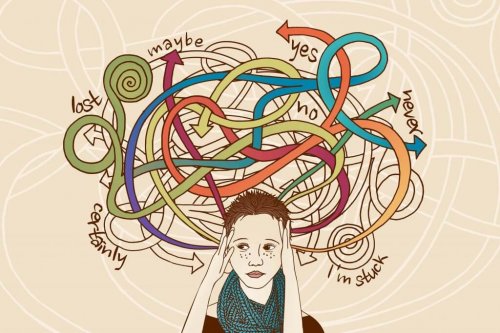Narrowing Your Options Can Help You Make Better Decisions

Do you think the number of options you have affects your decision-making process? Do you think your brain considers all the options that are presented to you? Would you be able to make better decisions if you had more or fewer options? In this article, we try to answer these questions.
Imagine that you go to a restaurant and the menu has about 100 dishes to choose from. Now, imagine that you go to the movies and there are over 50 films to pick from. How long would it take you to decide? Do you think you’d be satisfied with your choice? In most cases, having fewer options facilitates the decision-making process. This is because having fewer options also means less plausible scenarios you have to analyze.
“May your choices reflect your hopes, not your fears.”
-Nelson Mandela-
New technologies are focused on this. They filter information so that it’s more in tune with your tastes. Also, they leave simpler options in sight or they group them into categories so that it’s easier for you to make a decision. They do this so that your brain won’t need a lot of time to choose.
In addition, having fewer options favors also means that we’ll choose the one we believe is best. This is because it fits very well into the interests of our consumer society – they clearly don’t want us to remain stuck in a decision-making process. For example, we see this in those “special” offers for the first X orders.

The FOBO phenomenon
FOBO is an acronym for fear of better options. This phenomenon alludes to the action of postponing the decision-making process because we want to choose what’s best. The more time we have, the more options we can explore and the higher our chances of finding perfect alternatives. In many cases, this phenomenon only leads us to continue leaving decisions that we could make today for tomorrow.
On the other hand, in addition to the fear of missing out on the best option, what makes us repeat this strategy is the fact that it’s reinforced in a variable manner. On the other hand, there are times when we continue thinking about a decision we already made (we still think about cars or washing machines, even though we already bought one of each). And when a better option comes along (technology advances), we end up feeling completely overwhelmed.
In the 50s, Herbert Simon distinguished two types of people in terms of decision-making. At one end of the spectrum, we find the maximizing people, those who do their research until they find the best options. At the other end, we find those who focus on momentary satisfaction.
Although maximizing people usually make the best decisions, they can also fall into the trap of the FOBO phenomenon.
FOBO can lead to stress, depression, dissatisfaction, and lack of well-being since it doesn’t allow us to decide. On the contrary, it makes us constantly look for possibilities, making it impossible for the brain to rest and enjoy the chosen option. Therefore, more options don’t guarantee better decisions or greater satisfaction.
In a 2012 study, some researchers concluded that maximizing people were the most dissatisfied after having made a decision because they constantly questioned what they had chosen. Basically, after all that thinking and deliberation, they still felt insecure about their decision.
“In any moment of decision, the best thing you can do is the right thing, the next best thing is the wrong thing, and the worst thing you can do is nothing.”
-Theodore Roosevelt-

How to make better decisions
You can simplify the decision-making process by following three basic steps that lead you to narrow your options and make better decisions:
- The first step is clarifying the question “What do I want to achieve?” This allows you to narrow your options to only those that bring you closer to your desired goal.
- The second step is to identify the following steps according to the options you have. What tools do I need? How much time do I have? Do I have enough motivation to make this decision and choose this path? What is the first step I should take? This second step will help you create an action plan you can follow to make your decision.
- The last step is examining the decision’s long and short-term benefits. During this step, you have to figure out the pros and cons of the possibilities you have. This way, you’ll avoid making decisions based on your current emotions and for immediate needs. You need to ask yourself how a decision will affect you in a few months or in a few years.
With these simple steps, you’ll be able to optimize your decision-making process so you can make better decisions that will bring you closer to your goal.
Do you think the number of options you have affects your decision-making process? Do you think your brain considers all the options that are presented to you? Would you be able to make better decisions if you had more or fewer options? In this article, we try to answer these questions.
Imagine that you go to a restaurant and the menu has about 100 dishes to choose from. Now, imagine that you go to the movies and there are over 50 films to pick from. How long would it take you to decide? Do you think you’d be satisfied with your choice? In most cases, having fewer options facilitates the decision-making process. This is because having fewer options also means less plausible scenarios you have to analyze.
“May your choices reflect your hopes, not your fears.”
-Nelson Mandela-
New technologies are focused on this. They filter information so that it’s more in tune with your tastes. Also, they leave simpler options in sight or they group them into categories so that it’s easier for you to make a decision. They do this so that your brain won’t need a lot of time to choose.
In addition, having fewer options favors also means that we’ll choose the one we believe is best. This is because it fits very well into the interests of our consumer society – they clearly don’t want us to remain stuck in a decision-making process. For example, we see this in those “special” offers for the first X orders.

The FOBO phenomenon
FOBO is an acronym for fear of better options. This phenomenon alludes to the action of postponing the decision-making process because we want to choose what’s best. The more time we have, the more options we can explore and the higher our chances of finding perfect alternatives. In many cases, this phenomenon only leads us to continue leaving decisions that we could make today for tomorrow.
On the other hand, in addition to the fear of missing out on the best option, what makes us repeat this strategy is the fact that it’s reinforced in a variable manner. On the other hand, there are times when we continue thinking about a decision we already made (we still think about cars or washing machines, even though we already bought one of each). And when a better option comes along (technology advances), we end up feeling completely overwhelmed.
In the 50s, Herbert Simon distinguished two types of people in terms of decision-making. At one end of the spectrum, we find the maximizing people, those who do their research until they find the best options. At the other end, we find those who focus on momentary satisfaction.
Although maximizing people usually make the best decisions, they can also fall into the trap of the FOBO phenomenon.
FOBO can lead to stress, depression, dissatisfaction, and lack of well-being since it doesn’t allow us to decide. On the contrary, it makes us constantly look for possibilities, making it impossible for the brain to rest and enjoy the chosen option. Therefore, more options don’t guarantee better decisions or greater satisfaction.
In a 2012 study, some researchers concluded that maximizing people were the most dissatisfied after having made a decision because they constantly questioned what they had chosen. Basically, after all that thinking and deliberation, they still felt insecure about their decision.
“In any moment of decision, the best thing you can do is the right thing, the next best thing is the wrong thing, and the worst thing you can do is nothing.”
-Theodore Roosevelt-

How to make better decisions
You can simplify the decision-making process by following three basic steps that lead you to narrow your options and make better decisions:
- The first step is clarifying the question “What do I want to achieve?” This allows you to narrow your options to only those that bring you closer to your desired goal.
- The second step is to identify the following steps according to the options you have. What tools do I need? How much time do I have? Do I have enough motivation to make this decision and choose this path? What is the first step I should take? This second step will help you create an action plan you can follow to make your decision.
- The last step is examining the decision’s long and short-term benefits. During this step, you have to figure out the pros and cons of the possibilities you have. This way, you’ll avoid making decisions based on your current emotions and for immediate needs. You need to ask yourself how a decision will affect you in a few months or in a few years.
With these simple steps, you’ll be able to optimize your decision-making process so you can make better decisions that will bring you closer to your goal.
All cited sources were thoroughly reviewed by our team to ensure their quality, reliability, currency, and validity. The bibliography of this article was considered reliable and of academic or scientific accuracy.
- Larson, E. (2016, July 20). Por qué y cómo mejorar la toma de decisiones. Retrieved October 27, 2018, from https://hbr.es/toma-de-decisiones/95/por-qu-y-c-mo-mejorar-la-toma-de-decisiones.
- Tiempo, C. E. E. (2018, September 15). El fenómeno “fobo”: más opciones, peores decisiones. Retrieved October 27, 2018, from https://www.eltiempo.com/vida/salud/por-que-las-personas-tienden-a-postergar-la-toma-de-decisiones-268932.
This text is provided for informational purposes only and does not replace consultation with a professional. If in doubt, consult your specialist.







